Implementing Jobs to be Done (JTBD) in UX Design Guide

The Jobs to be Done (JTBD) coupled with an effective digital transformation strategy and innovation strategy in User Experience (UX) design takes centre stage as a catalyst for transformative design. Understanding and addressing the Jobs to be Done is not merely a step in the UX process; it’s a cornerstone.
Digital Leadership emerges as a trailblazer, navigating organizations through the intricacies of digital strategy and strategy execution. With a commitment to guiding entities from strategic formulation to seamless execution, Digital Leadership is dedicated to enhance tangible value creation for all stakeholders. Digital Leadership integrates Jobs to be Done principles seamlessly into its Innovation Consulting and Customer Experience Consulting services. By decoding fundamental customer jobs, our approach ensures strategic innovation aligned with market needs. As an initial step to assist businesses in selecting tailored services that align with their specific needs and objectives for innovation, we offer an Innovation Blueprint to evaluate current innovation practices.
From establishing a clear definition of JTBD to deciphering its seamless integration into UX research, we’re set to unravel the layers of this framework. The preview sets the stage for a comprehensive understanding of how JTBD distinguishes itself among various mental models in User Experience. Get ready to embark on a journey that illuminates the transformative potential of Jobs to be Done in crafting meaningful and impactful user experiences.
What is Jobs to Be Done (JTBD) Theory
At its essence, the Jobs to be Done theory is a powerful framework centred around comprehending the underserved customer needs and desired outcomes that propel users toward specific products or services. It goes beyond traditional demographic data, focusing on the underlying motivations that drive users to make particular choices. In this section, we delve into the core tenets of the JTBD theory, establishing a foundational understanding that will underpin its application in the realm of User Experience (UX).
Unpacking the characteristics of a JTBD deliverable is key to crafting solutions that genuinely resonate with users. From clarity in articulating user needs to align with their perspectives, a JTBD deliverable becomes a linchpin in the UX design process. This exploration illuminates the nuances that make JTBD a potent tool for creating user-centric designs.
The Value Proposition Canvas plays a pivotal role in the Jobs to Be Done (JTBD) methodology, offering crucial importance in understanding and enhancing customer experiences. It serves as a visual tool that enables organizations to meticulously map out customer profiles, including their pains, gains, and jobs to be done. This canvas becomes instrumental in aligning product or service offerings with customer needs, ensuring a compelling and customer-centric value proposition. You can download it now.
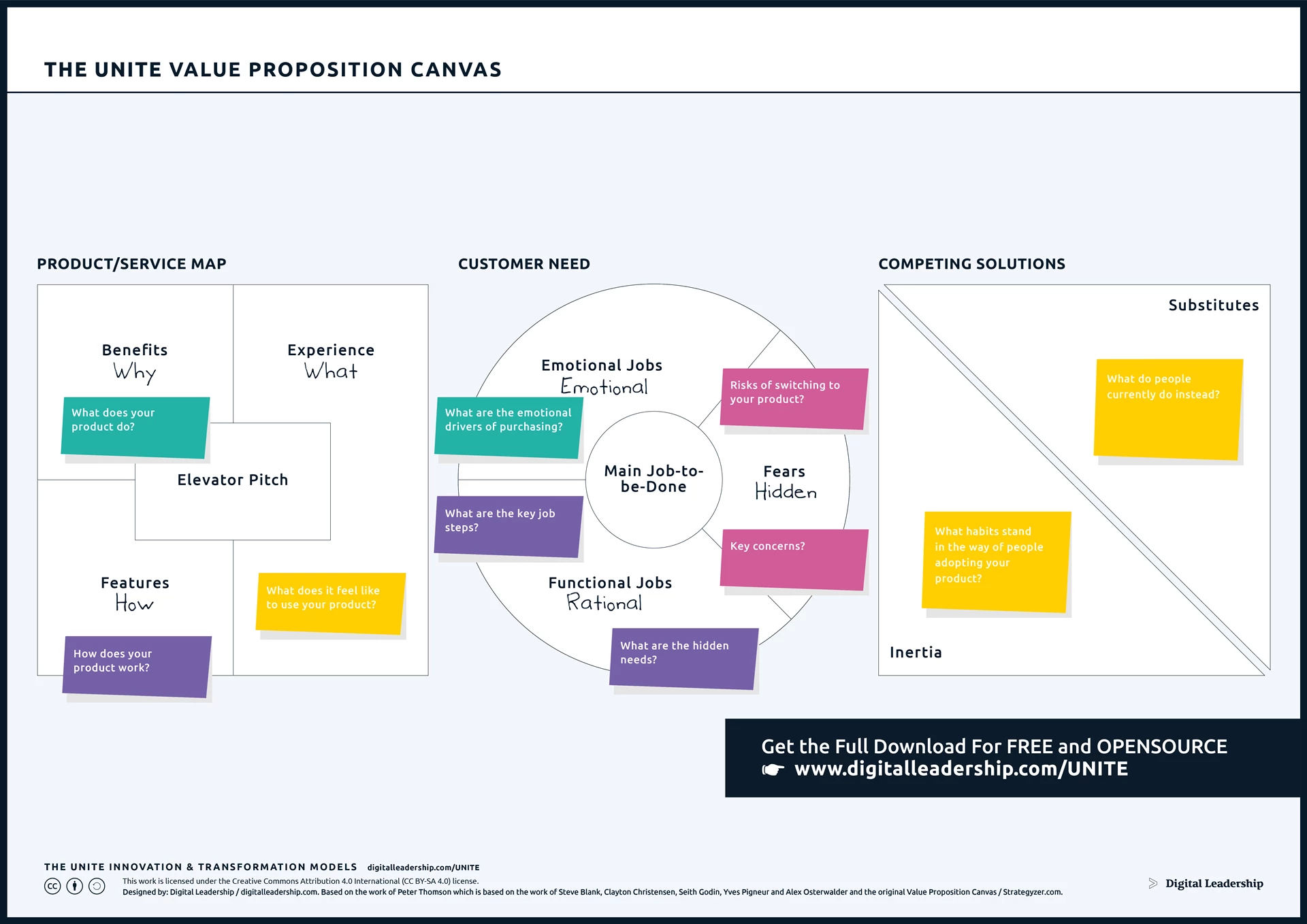
Designed by: Digital Leadership AG – Based on the work of Peter Thomson which is based on the work of Steve Blank, Clayton Christensen, Seith Godin, Yves Pigneur and Alex Osterwalder and the original Value Proposition Canvas
Download the complete Value Proposition Canvas Package, including instructions for putting it to work for you today.
What is UX Design
User Experience (UX) design encompasses the comprehensive development of the entire product acquisition and integration process, covering elements such as branding, design, usability, and functionality. It is a multidisciplinary approach focused on crafting products, services, and systems that provide meaningful and enjoyable experiences for users. It encompasses every aspect of the user’s interaction with a product, aiming to make those interactions seamless, efficient, and delightful.
Jobs to be done framework in UX encourages a user-centric approach, urging designers to delve into the motivations and desired outcomes that drive user behavior. By identifying the core jobs users are hiring a product or service to fulfill, UX designers gain valuable insights for crafting more meaningful and impactful experiences. This goes beyond surface-level features, allowing for the personalization of designs based on the specific needs users are trying to address.
JTBD aligns seamlessly with UX research methodologies, emphasizing in-depth user interviews to uncover motivations and preferences. The integration of JTBD principles in UX design not only guides the creation of user-centric solutions but also fosters continuous innovation and iteration, ensuring that products evolve in tandem with changing user expectations. Ultimately, JTBD serves as a strategic framework for UX designers, empowering them to make informed decisions and create designs that resonate with users on a deeper level.
Much more about Jobs to be done, and other approaches to innovation strategy you will find in our brand-new FREE book “How to Create Innovation” Register for the download now!
Pros and Cons of Jobs to be Done Framework in UX
Advantages of Implementing Jobs to be done in UX
- 1. Enhanced User Understanding: JTBD provides deep insights into user motivations, moving beyond demographics for a profound understanding of needs.
- 2. Improved Product Innovation: By focusing on fundamental user jobs, JTBD becomes a compass for innovation aligned with genuine user needs.
- 3. Holistic View of User Needs: Offers a comprehensive understanding of user needs, addressing immediate requirements and broader goals.
- 4. Effective Decision-Making: Informs strategic decision-making in UX design, aligning choices with user priorities.
- 5. Customer-Centric Designs: Places the customer at the centre, contributing to increased satisfaction and loyalty.
Potential Challenges and Limitations of Implementing Jobs to be done in UX
- 1. Complexity in Implementation: Effective implementation demands a nuanced understanding of JTBD theory.
- 2. Data Collection Challenges: Gathering data for user jobs may pose challenges in terms of qualitative research execution.
- 3. Interpretation Subjectivity: Interpreting JTBD insights may be subjective, introducing potential interpretation bias.
- 4. Time and Resource Intensive: Comprehensive JTBD research can be time and resource-intensive.
- 5. Integration with Existing Processes: Seamlessly integrating JTBD into existing UX processes may require adjustments and organizational flexibility.
Steps in Implementing JTBD in UX With Templates
Step 1: Crafting the JTBD Statement
Crafting the Job to Be Done (JTBD) statement involves a two-step process that begins with formulating a concise and customer-centric statement capturing the essence of the user’s need. The JTBD statement is written in the customer’s voice, employing a structured sentence format that encompasses their improvement direction, the aspect being improved, the affected entity, and a contextual clarifier. For instance: “As an online shopper, I want to streamline the checkout process to save time and reduce frustration.”
The UNITE JTBD Customer’s Job Statement Model, ensures clear, insightful, and solution-agnostic statements, forming the cornerstone of the Jobs to Be Done Framework. These statements align organizational strategies with authentic customer needs, fostering a profound understanding of an effective JTBD process.
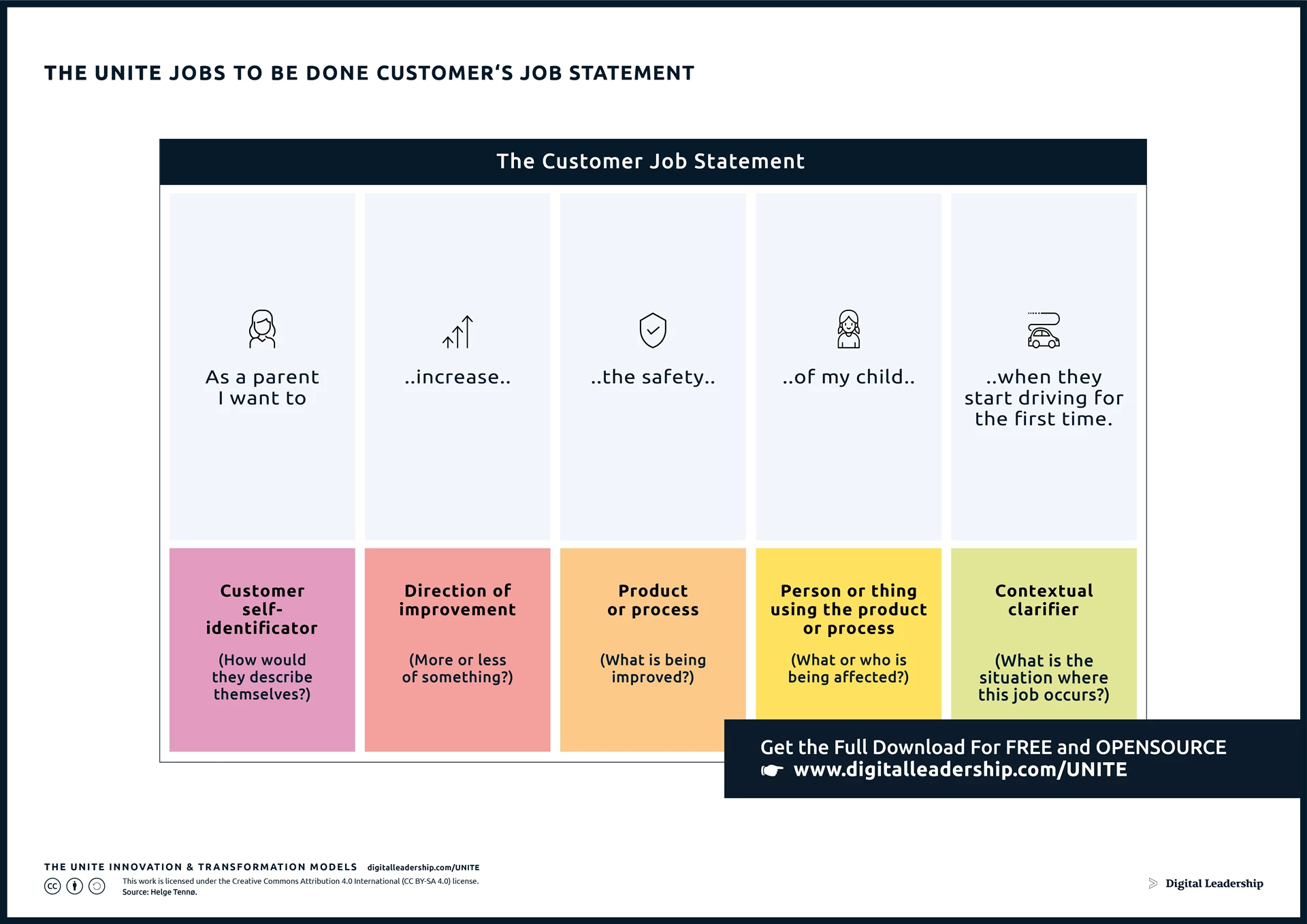
Designed by: Digital Leadership AG – Source: Helge Tennø.
Your download is now available!
You can now access the complete JTBD Customer’s Job Statement Package, including a full presentation, related models and instructions for use.
Step 2: Developing the JTBD Journey Map
The jobs to be done Journey Map, a vital component of the Jobs to Be Done (JTBD) framework in UX, serves to outline the various steps and tasks users undertake to accomplish a specific job. This comprehensive tool is instrumental in gaining insights into user behavior and needs. Utilizing the eight steps of the Job Mapping process, the goal is to delineate the smaller tasks and activities users perform to fulfill their job. This mapping process provides a holistic view of the user journey, facilitating a deep understanding of their interactions and helping design solutions that align with their goals and expectations in the realm of UX.
Incorporating “The UNITE Jobs to Be Done Universal Map” Model enhances this step. It provides a visual representation, ensuring a comprehensive understanding of the customer journey, and helping businesses align strategies with identified jobs effectively.
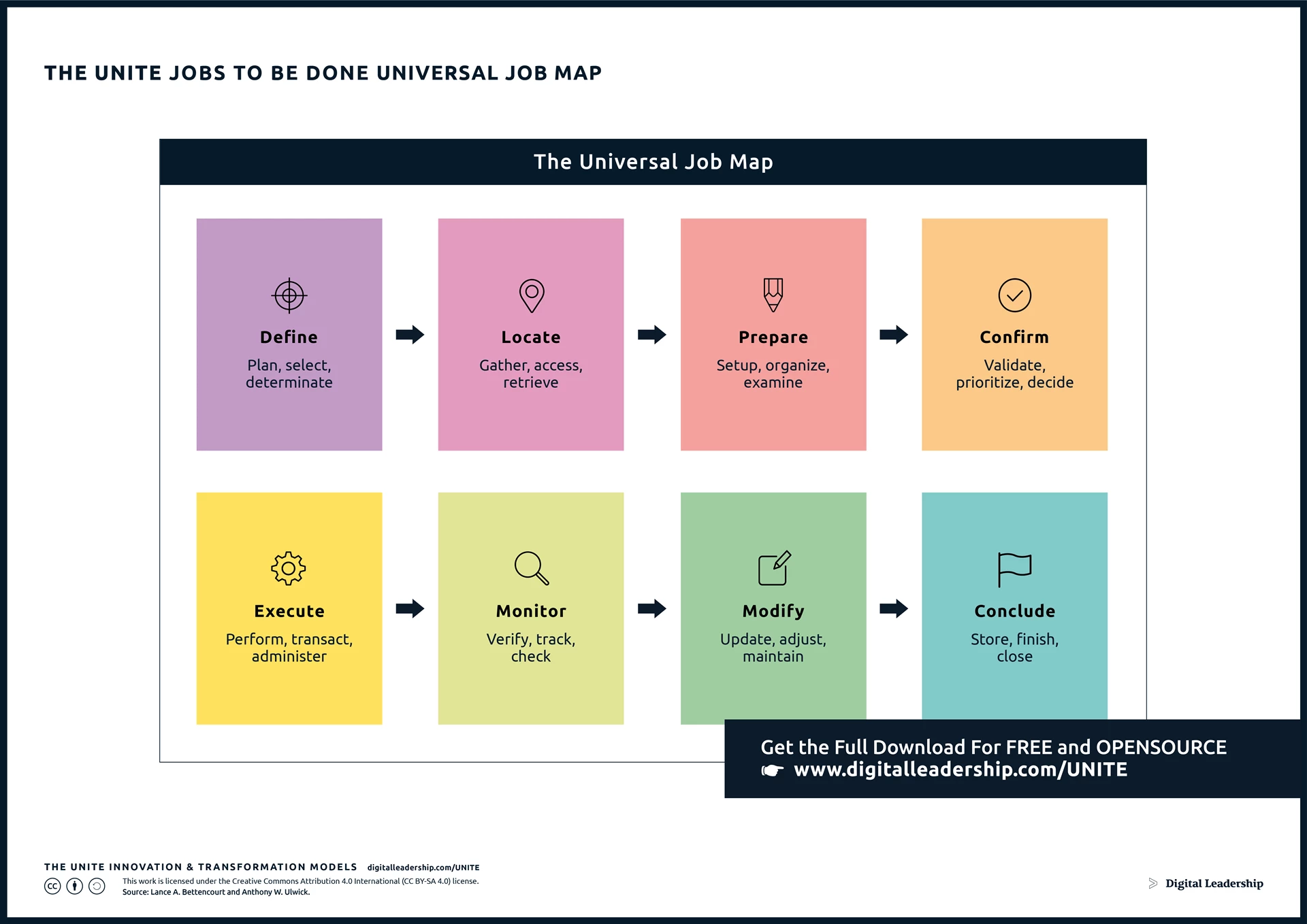
Designed by: Digital Leadership AG – Source: Lance A. Bettencourt and Anthony W. Ulwick.
Your download is now available!
You can now access the complete Jobs to be Done Universal Map Package, including a full presentation, related models and instructions for use.
The Job Map involves outlining the smaller tasks and activities that customers undertake to accomplish their job. This is a collaborative process where the team gathers to brainstorm and categorize tasks into eight steps. The Universal Job Map comprises the following steps:
- Define and plan: The customer consciously or subconsciously creates an initial plan for their approach.
- Locate the input needed: Identifying and locating information necessary for decision-making.
- Prepare: Organizing information, filtering, qualifying, and making decisions.
- Confirm and validate: Making decisions and validating them.
- Execute: Performing the action or procedure resulting from the decision.
- Monitor: Monitoring the effects and outcomes of the decision.
- Modify: Assessing the decision based on new information and continuously monitoring or improving.
- Conclude: Concluding the journey, taking stock, and learning from the experience.
Step 3: Identifying Customer Jobs through interviews
- User Qualitative Interviews and Observations: Direct interaction offers valuable qualitative data.
- Surveys and Questionnaires: Structured tools quantify user jobs from a diverse user base.
- Data Analysis from User Interactions: Analyzing User Behaviour Unveils Implicit Jobs.
- Social Listening and Online Forums: Monitoring discussions provides insights from natural conversations.
The UNITE Jobs-to-be-Done template is recommended for defining Customer Criteria in the context of UX design, providing a structured approach to gathering essential information for the design process. The methodology encourages a holistic understanding of customer needs and preferences, ensuring that UX design aligns closely with the jobs customers are trying to get done.

Designed by: Digital Leadership AG – Source: Strategyn
Your download is now available!
You can now access the complete Jobs to Be Done Template for Defining Customer Criteria Package, including a full presentation, related models and instructions for use.
Step 4: Analyzing and Defining Each JTBD
- Task Analysis: Break down jobs into tasks for detailed design understanding.
- User Journey Mapping: Visualize user journeys for a holistic view of interactions.
- Persona Integration: Integrate personas for a deeper understanding.
- Collaborative Workshops: Involve cross-functional teams for comprehensive analysis.
Step 5: Listing Users’ Desired Outcomes
- Outcome Prioritization Surveys: Collect user input to prioritize outcomes.
- Impact-Effort Matrix: Evaluate impact and effort for prioritization.
- Contextual Inquiry: Immerse in user environments for nuanced outcome understanding.
- Collaborative Brainstorming: Engage teams in brainstorming sessions for a comprehensive outcome list.
Step 6: Crafting a Jobs to Be Done Statement
- User-Centric Language: Frame statements in user language.
- Identification of Improvement: Clearly articulate user improvement.
- Contextual Clarity: Provide context for focused statements.
- Solution-Agnostic Approach: Maintain a solution-agnostic stance.
Step 7: Identifying Competitors
- Competitor Analysis Frameworks: Utilize frameworks for comprehensive analysis.
- User Feedback on Competitor Products: Analyze user feedback for competitor product insights.
- Benchmarking Studies: Conduct studies to compare product performance.
- Industry Landscape Research: Stay informed about industry trends.
Step 8: Evaluating and Identifing Opportunities
- Impact-Feasibility Analysis: Assess impact against feasibility for prioritization.
- User Feedback Prioritization: Leverage user feedback for prioritization.
- Stakeholder Alignment Workshops: Involve stakeholders for balanced decision-making.
- Agile Prioritization Techniques: Implement agile techniques for systematic prioritization.
Utilizing tools such as the Job Journey Navigator, like the one offered by Vendbridge, every Customer Criterion is mapped out in alignment with the previously created Job Map. This visualization assists the team in easily identifying significant opportunities, facilitating prioritization for envisioning potential solutions.
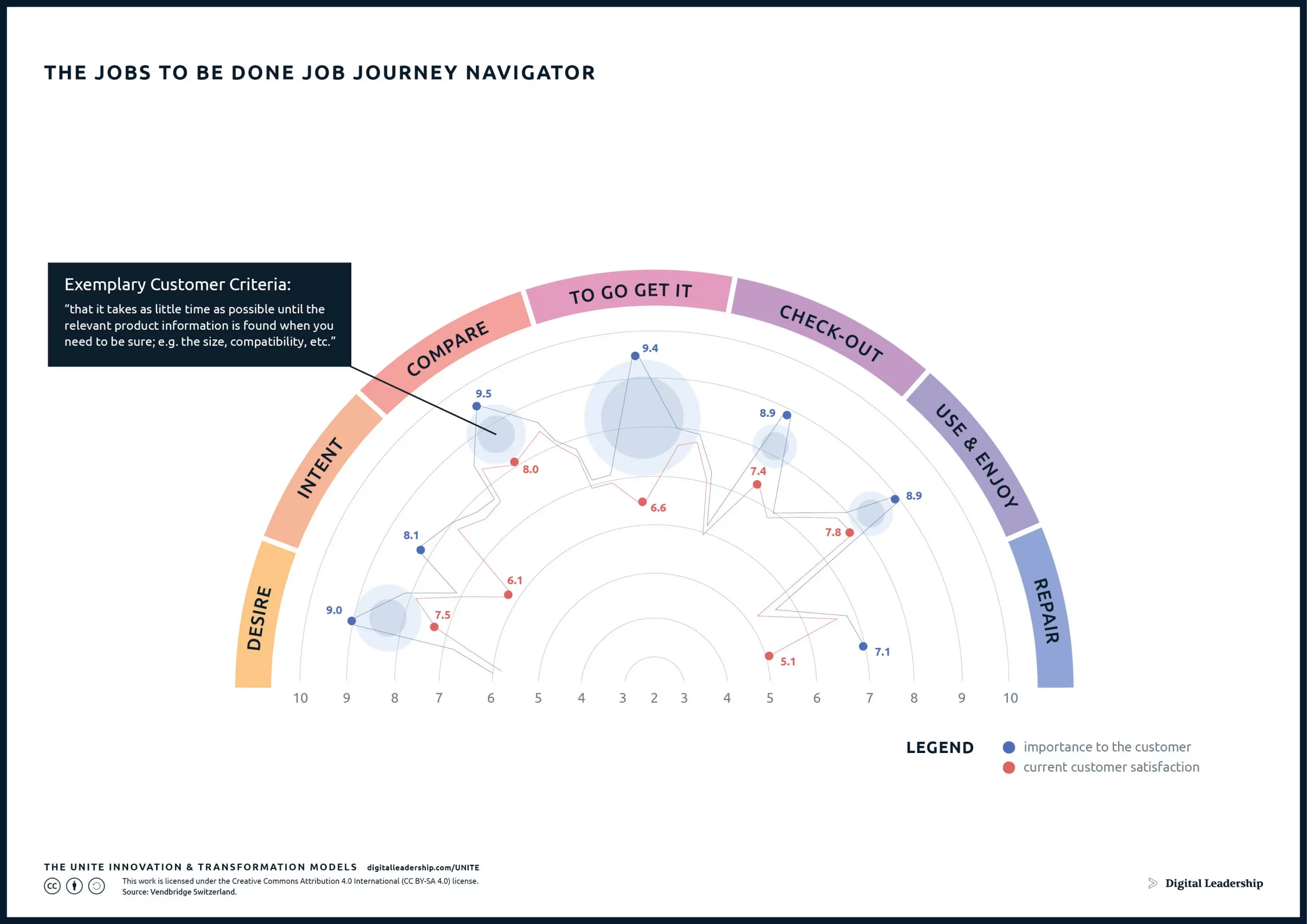
Designed by: Digital Leadership AG – Source: Vendbridge Switzerland.
Your download is now available!
You can now access the complete Jobs to Be Done Journey Navigator Package, including a full presentation, related models and instructions for use.
Step 9: Designing Solutions for Desired Outcomes
- Collaborative Design Thinking Sessions: Engage teams in creative design sessions.
- Prototyping and Testing: Rapidly prototype and iterate based on user testing.
- Usability Heuristics Application: Apply heuristics for usability and efficiency.
- Contextual Inquiry in Design: Integrate contextual inquiry for real-world insights.
Consider turning the UNITE Customer Promise Canvas into a team competition. Have individuals collaborate to create competing promises for the same unmet need, using the scoring mechanism on the canvas to determine the most effective solution. The canvas serves as a tool to explore how needs align with promises and helps filter opportunities, leaving you more confident and enthusiastic about the selected promises.
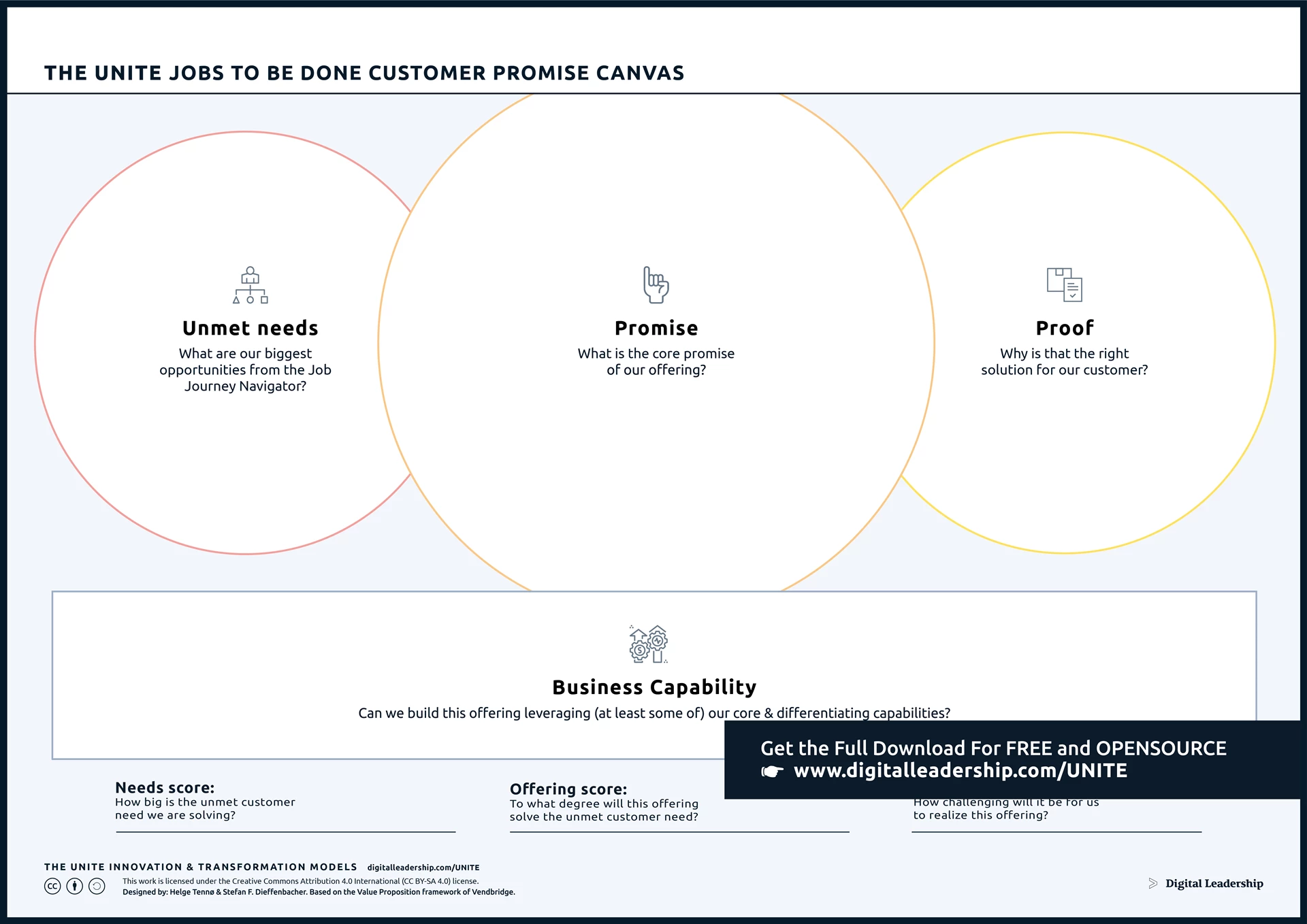
Designed by: Helge Tennø & Stefan F. Dieffenbacher. Based on the Value Proposition framework of Vendbridge
Your download is now available!
You can now access the complete Jobs to Be Done Customer Promise Canvas Package, including a full presentation, related models and instructions for use.
Step 10: Tracking and Measuring Post-Launch Changes
- User Analytics and Metrics: Implement analytics tools for post-launch tracking.
- Surveys and Feedback Loops: Continuously gather user feedback for insights.
- A/B Testing and Iterative Development: Conduct A/B testing for iterative improvements.
- User Interviews for Post-Launch Insights: Schedule interviews for qualitative post-launch insights.
Jobs to Be Done Examples For Customer User Experience (UX)
- Job: Quickly Find Relevant Information on a Website
- Context: A user visiting a news website.
- JTBD Statement: “When I’m on a news website, I want to quickly find relevant information on current events, so I can stay informed without spending too much time searching.”
- Job: Effortlessly Complete an Online Purchase
- Context: A user shopping on an e-commerce platform.
- JTBD Statement: “When I’m shopping online, I want to effortlessly complete the purchase process, so I can buy the products I need without encountering confusing or time-consuming steps.”
- Job: Seamlessly Collaborate with Remote Team Members
- Context: A user using a collaborative work platform.
- JTBD Statement: “As a remote worker, I want a collaboration tool that allows seamless communication and document sharing, so I can work efficiently with my team regardless of geographic distances.”
- Job: Easily Navigate and Explore a Mobile App
- Context: A user interacting with a mobile application.
- JTBD Statement: “When using a mobile app, I want an intuitive navigation system, so I can easily explore features and accomplish tasks without feeling lost or frustrated.”
- Job: Learn a New Skill Through Online Courses
- Context: A user engaging with an e-learning platform.
- JTBD Statement: “As a lifelong learner, I want an e-learning platform that offers courses aligned with my interests and provides a user-friendly experience, so I can acquire new skills at my own pace.”
- Job: Monitor and Analyze Personal Health Data
- Context: A user using a health and fitness tracking app.
- JTBD Statement: “When tracking my health and fitness, I want an app that allows me to monitor and analyze my data easily, so I can make informed decisions about my well-being.”
- Job: Streamline Travel Planning and Itinerary Management
- Context: A user planning a trip using a travel application.
- JTBD Statement: “When planning a trip, I want a travel app that streamlines itinerary management, provides real-time updates, and offers recommendations, so I can have a stress-free travel experience.”
- Job: Manage Personal Finances Effectively
- Context: A user utilizing a finance management app.
- JTBD Statement: “As someone managing personal finances, I want a finance app that simplifies expense tracking, generates insightful reports, and offers tips for better financial management, so I can achieve my financial goals.”
How UX Teams Can Leverage the Jobs-to-be-Done Framework
These examples and templates showcase the practical applications of JTBD in UX design, emphasizing its effectiveness in creating user-centric solutions across various domains.
Empowering UX Teams with JTBD:
- Workshops and Training: Conduct sessions to familiarize teams with JTBD concepts through real-world examples and case studies.
- Collaborative Learning: Encourage a culture of sharing experiences and insights related to applying JTBD in projects.
- Cross-Functional Collaboration: Facilitate collaboration between designers, researchers, and stakeholders for a holistic approach aligned with business goals.
- Knowledge Sharing: Organize regular sessions for team members to present JTBD-related findings, methodologies, and success stories.
Context in JTBD: Enhancing Relevance:
- Contextual Inquiry: Incorporate contextual inquiry into research methods to understand how users’ job scenarios are influenced by their environment.
- User Journey Mapping: Integrate context into journey maps to identify touchpoints where external factors significantly impact user decisions.
- Persona Enhancement: Enhance user personas by including contextual elements, highlighting different scenarios in which users engage with products.
- Scenario-based Design: Adopt scenario-based design approaches to envision how users’ jobs unfold in various real-world situations.
Switch Interviews for Insightful Decisions:
- Identify Switching Moments: Pinpoint key moments when users contemplate switching solutions due to dissatisfaction, unmet needs, or evolving preferences.
- Open-ended Questions: Frame questions encouraging users to narrate their switching experiences and focus on factors influencing their decisions.
- Probe for Contextual Details: Dig deeper into the context surrounding the switching decision, exploring external factors, emotional triggers, and specific scenarios.
- Document User Narratives: Capture detailed user narratives during switch interviews, providing rich insights for UX design.
Addressing UX Design Challenges Through JTBD:
JTBD operates on a user-centric philosophy, aligning seamlessly with UX goals to create intuitive and impactful designs. By delving into the dynamics of problem-solution relationships, JTBD uncovers latent user needs, serving as a guiding force in the design process. The step-by-step implementation guide covers initiation, research, competitor analysis, opportunity prioritization, design, and post-launch analysis, ensuring a comprehensive roadmap for success. Emphasizing the benefits, JTBD fosters user-centricity, catalyzes innovation, mitigates risks, and champions continuous improvement, making it an invaluable framework for enhancing the UX design landscape.
- Superficial Understanding:
- Pitfall: Relying on surface-level demographics for design decisions.
- JTBD Solution: Offers a profound understanding of user motivations and desired outcomes, guiding designs beyond superficial elements.
- Lack of Innovation Strategy:
- Pitfall: Stagnation in product design without genuine innovation.
- JTBD Solution: Serves as a compass for innovation by focusing on fundamental user jobs, fostering creative and user-centric solutions.
- Neglecting User Context:
- Pitfall: Designing in isolation without considering the broader context of user needs.
- JTBD Solution: Considers the complete user context, ensuring designs address immediate requirements and broader goals.
- Uninformed Decision-Making:
- Pitfall: Lack of strategic decision-making in the design process.
- JTBD Solution: Informed decision-making by aligning design choices with user priorities, creating solutions that resonate with users.
- Not Prioritizing Customer-Centricity:
- Pitfall: Designs that are not rooted in the user’s journey.
- JTBD Solution: Places the customer at the center, contributing to user-friendly and customer-centric designs.
- Missing Core User Job:
- Pitfall: Overlooking crucial user jobs in the design process.
- JTBD Solution: Utilizes user interviews, observations, surveys, and data analysis to identify and prioritize core user jobs.
- Incomplete Job Analysis:
- Pitfall: Inadequate analysis and definition of identified user jobs.
- JTBD Solution: Incorporates methodologies like task analysis, user journey mapping, persona integration, and collaborative workshops for comprehensive job definition.
- Neglecting User Outcomes:
- Pitfall: Focusing on tasks rather than desired outcomes in UX design.
- JTBD Solution: Prioritizes and aligns user’s desired outcomes with the UX design process using outcome prioritization surveys, impact-effort matrix, and more.
- Vague JTBD Statements:
- Pitfall: Unclear or overly detailed Jobs to be Done statements.
- JTBD Solution: Crafts concise and impactful statements using user-centric language, identification of improvement, contextual clarity, and a solution-agnostic approach.
- Ignoring Competitor Landscape:
- Pitfall: Neglecting to consider the competitive context in design decisions.
- JTBD Solution: Involves competitor analysis frameworks, user feedback on competitor products, benchmarking studies, and industry landscape research.
- Overlooking Opportunities:
- Pitfall: Missing valuable opportunities for UX enhancement.
- JTBD Solution: Systematically evaluates and prioritizes opportunities using impact-feasibility analysis, user feedback prioritization, stakeholder alignment workshops, and agile prioritization techniques.
- Designs Misaligned with Outcomes:
- Pitfall: Creating solutions that don’t align with user-desired outcomes.
- JTBD Solution: Translates JTBD insights into compelling designs through collaborative design thinking sessions, prototyping and testing, usability heuristics application, and contextual inquiry in design.
- Failure to Iterate Post-Launch:
- Pitfall: Lack of continuous improvement based on user interactions.
- JTBD Solution: Involves user analytics and metrics, surveys and feedback loops, A/B testing, and user interviews for post-launch insights, ensuring ongoing refinement and optimization.
Differentiating Jobs-to-be-Done vs. User Personas:
Jobs-to-be-Done (JTBD) and User Personas are both valuable tools in the realm of user experience design, but they serve distinct purposes and offer different perspectives. Let’s explore the key differentiators between Jobs-to-be-Done and User Personas:
| spect | Jobs-to-be-Done (JTBD) | User Personas |
|---|---|---|
| Focus and Perspective | Centers around specific jobs or tasks users are trying to accomplish, exploring functional, emotional, and social aspects of the job. | Focuses on creating semi-fictional representations of typical users, emphasizing characteristics, behaviors, and goals of a specific user group. |
| Level of Abstraction | Provides a concrete and task-oriented view, addressing specific activities and goals users have in a given context. | Offers a higher level of abstraction, capturing generalized traits and behaviors of a group without pinpointing specific tasks. |
| Timing and Context | Emphasizes the context in which a job is performed and the timeline of when a user is motivated to get a job done, accounting for situational factors. | Typically lacks a time-bound context and focuses more on understanding overall characteristics and preferences of a user group. |
| Use in Design Process | Guides the design process by helping identify and prioritize critical jobs users are trying to accomplish, acting as a framework for creating solutions. | Informs the design process by providing a reference for decision-making based on assumed preferences and behaviors of the targeted user group. |
| Empathy vs. Functionality | Aims to understand deeper motivations and emotional aspects behind user actions, exploring the “why” behind what users want to achieve. | Primarily focuses on demographic and psychographic details of users, fostering empathy by relating to users on a personal level. |
| Scope of Application | Particularly effective in innovation, product development, and understanding driving forces behind users’ choices. | Commonly used for creating a shared understanding of the target audience, ensuring design decisions align with user expectations. |
| Flexibility and Adaptability | Adaptable across various contexts and industries, providing a versatile framework for understanding user needs and driving innovation. | Tailored to specific user segments, offering a focused approach but may be less adaptable to contexts beyond the defined personas. |
Conclusion
In conclusion, this comprehensive exploration of Jobs-to-be-Done (JTBD) in UX design has unveiled key insights and methodologies to empower UX teams in creating more user-centric and impactful experiences. As we recap the key takeaways from each section, it becomes evident that JTBD provides a unique lens through which to understand and address user needs. Emphasizing the transformative power of JTBD in UX, this framework emerges as a catalyst for innovation and user satisfaction. The call to encourage the adoption of JTBD resonates as a pathway to enhanced user-centric experiences, urging UX practitioners to integrate this powerful methodology into their design practices for lasting success.
Recent Posts

Business Level Strategy Examples, Types, Definition and Implementing Steps For Successful Strategy
Social ShareIn the business environment, the choice of an effective strategy can...
View Full article
Radical Innovation Meaning, Examples and Characteristics
Social ShareRadical innovation is a main type of innoavtion that involves the...
View Full article





























 Book How to Create Innovation
Book How to Create Innovation